Maintain and Apply Technical Engineering Skills: Case Analysis
VerifiedAdded on 2023/06/11
|10
|2547
|89
Case Study
AI Summary
This case study examines the application of technical engineering skills within civil engineering, emphasizing the roles and responsibilities of a civil engineer in managing construction sites, communicating with stakeholders, and addressing non-conformance issues. It covers the importance of adhering to safety engineering principles, understanding material properties, and staying updated with industry developments. The study further identifies situations requiring specialist assistance and stresses the need for continuous professional development to enhance technical frameworks within the organization. The analysis includes a discussion on the causes and effects of non-conformances, the application of safety principles, and the importance of adhering to relevant legislation and standards. Finally, it proposes solutions for improvement, advocating for the consistent application of safety engineering principles and relevant regulations to ensure worker safety and project quality. Desklib provides access to similar solved assignments and past papers for students.
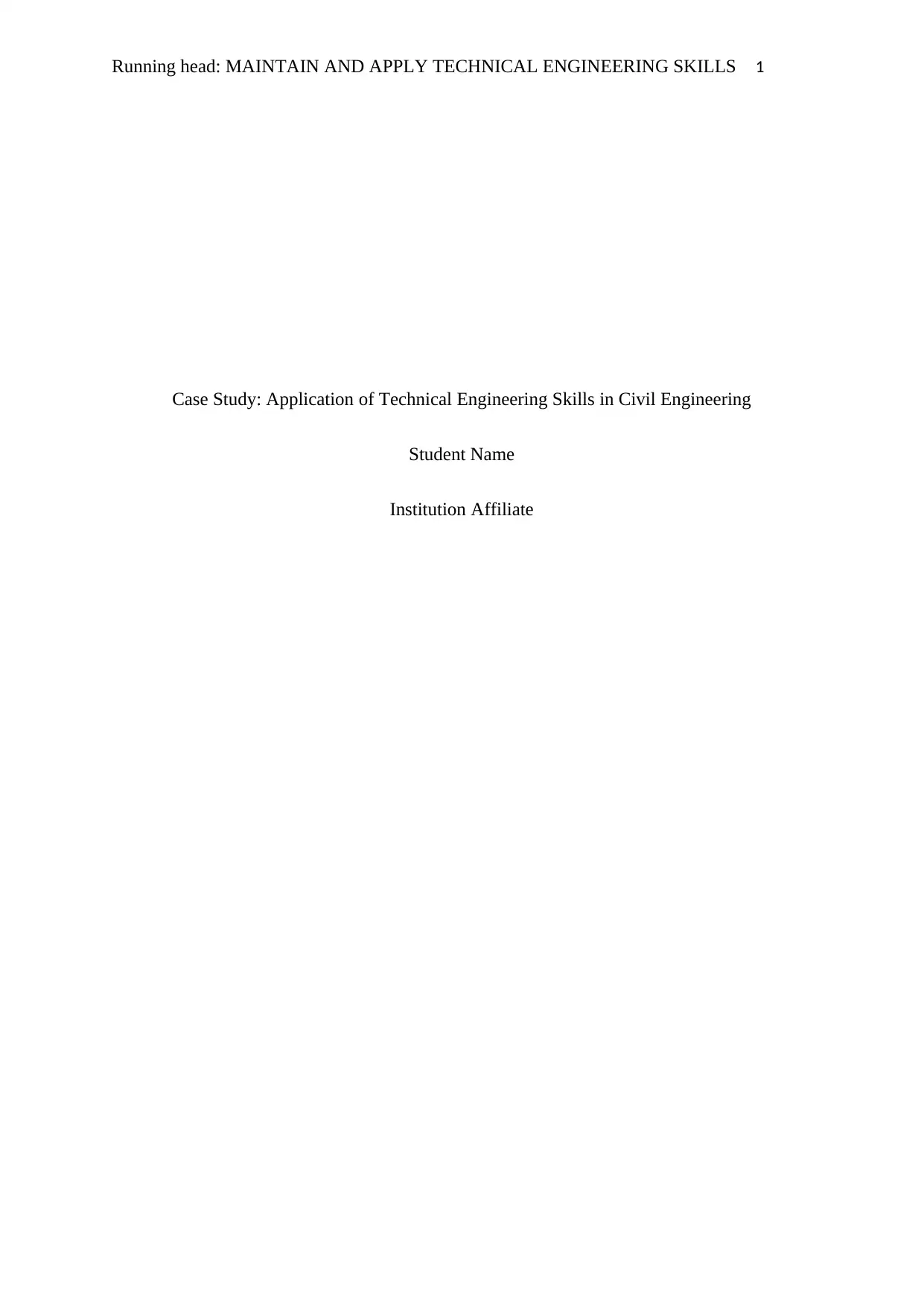
Running head: MAINTAIN AND APPLY TECHNICAL ENGINEERING SKILLS 1
Case Study: Application of Technical Engineering Skills in Civil Engineering
Student Name
Institution Affiliate
Case Study: Application of Technical Engineering Skills in Civil Engineering
Student Name
Institution Affiliate
Paraphrase This Document
Need a fresh take? Get an instant paraphrase of this document with our AI Paraphraser
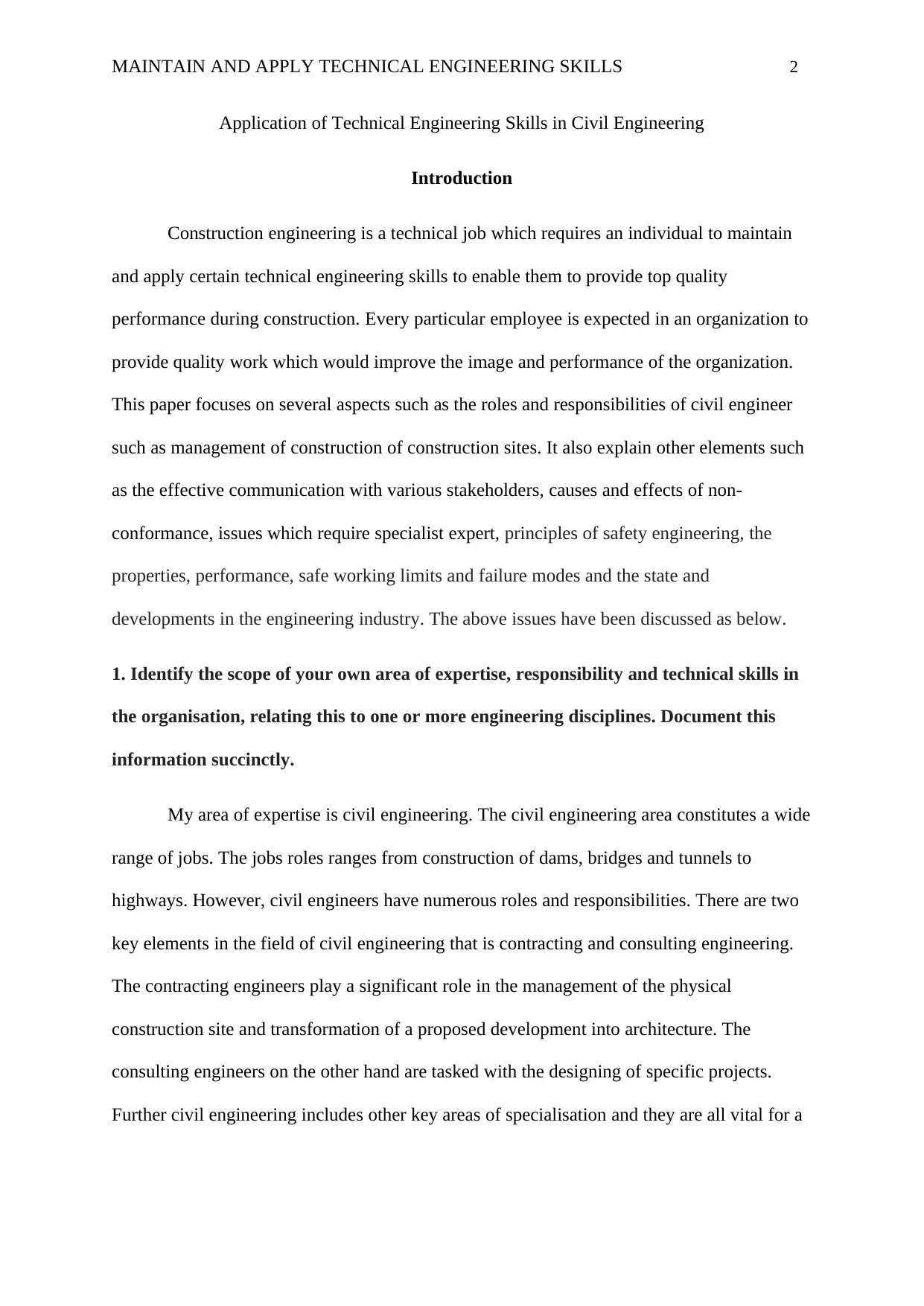
MAINTAIN AND APPLY TECHNICAL ENGINEERING SKILLS 2
Application of Technical Engineering Skills in Civil Engineering
Introduction
Construction engineering is a technical job which requires an individual to maintain
and apply certain technical engineering skills to enable them to provide top quality
performance during construction. Every particular employee is expected in an organization to
provide quality work which would improve the image and performance of the organization.
This paper focuses on several aspects such as the roles and responsibilities of civil engineer
such as management of construction of construction sites. It also explain other elements such
as the effective communication with various stakeholders, causes and effects of non-
conformance, issues which require specialist expert, principles of safety engineering, the
properties, performance, safe working limits and failure modes and the state and
developments in the engineering industry. The above issues have been discussed as below.
1. Identify the scope of your own area of expertise, responsibility and technical skills in
the organisation, relating this to one or more engineering disciplines. Document this
information succinctly.
My area of expertise is civil engineering. The civil engineering area constitutes a wide
range of jobs. The jobs roles ranges from construction of dams, bridges and tunnels to
highways. However, civil engineers have numerous roles and responsibilities. There are two
key elements in the field of civil engineering that is contracting and consulting engineering.
The contracting engineers play a significant role in the management of the physical
construction site and transformation of a proposed development into architecture. The
consulting engineers on the other hand are tasked with the designing of specific projects.
Further civil engineering includes other key areas of specialisation and they are all vital for a
Application of Technical Engineering Skills in Civil Engineering
Introduction
Construction engineering is a technical job which requires an individual to maintain
and apply certain technical engineering skills to enable them to provide top quality
performance during construction. Every particular employee is expected in an organization to
provide quality work which would improve the image and performance of the organization.
This paper focuses on several aspects such as the roles and responsibilities of civil engineer
such as management of construction of construction sites. It also explain other elements such
as the effective communication with various stakeholders, causes and effects of non-
conformance, issues which require specialist expert, principles of safety engineering, the
properties, performance, safe working limits and failure modes and the state and
developments in the engineering industry. The above issues have been discussed as below.
1. Identify the scope of your own area of expertise, responsibility and technical skills in
the organisation, relating this to one or more engineering disciplines. Document this
information succinctly.
My area of expertise is civil engineering. The civil engineering area constitutes a wide
range of jobs. The jobs roles ranges from construction of dams, bridges and tunnels to
highways. However, civil engineers have numerous roles and responsibilities. There are two
key elements in the field of civil engineering that is contracting and consulting engineering.
The contracting engineers play a significant role in the management of the physical
construction site and transformation of a proposed development into architecture. The
consulting engineers on the other hand are tasked with the designing of specific projects.
Further civil engineering includes other key areas of specialisation and they are all vital for a
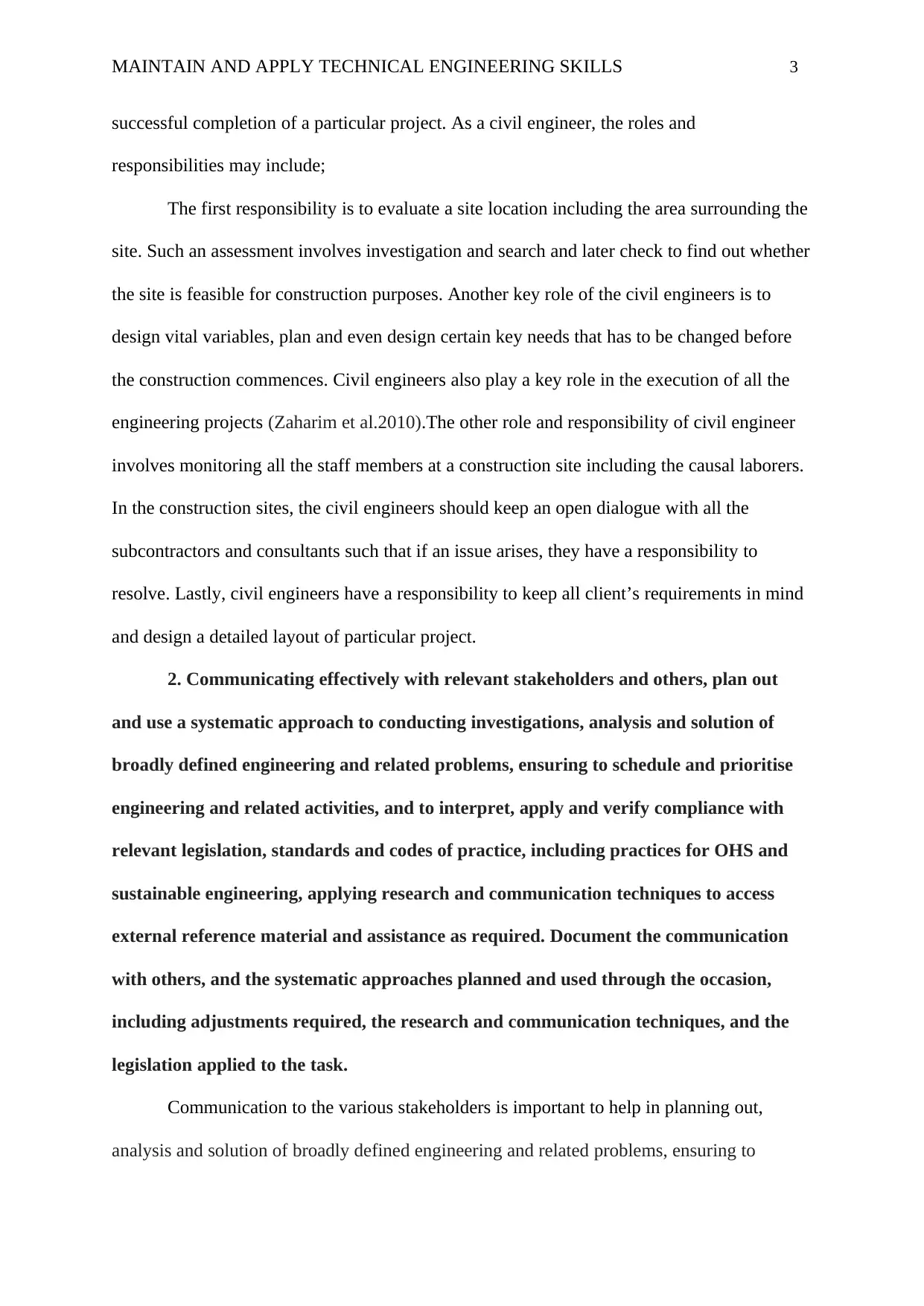
MAINTAIN AND APPLY TECHNICAL ENGINEERING SKILLS 3
successful completion of a particular project. As a civil engineer, the roles and
responsibilities may include;
The first responsibility is to evaluate a site location including the area surrounding the
site. Such an assessment involves investigation and search and later check to find out whether
the site is feasible for construction purposes. Another key role of the civil engineers is to
design vital variables, plan and even design certain key needs that has to be changed before
the construction commences. Civil engineers also play a key role in the execution of all the
engineering projects (Zaharim et al.2010).The other role and responsibility of civil engineer
involves monitoring all the staff members at a construction site including the causal laborers.
In the construction sites, the civil engineers should keep an open dialogue with all the
subcontractors and consultants such that if an issue arises, they have a responsibility to
resolve. Lastly, civil engineers have a responsibility to keep all client’s requirements in mind
and design a detailed layout of particular project.
2. Communicating effectively with relevant stakeholders and others, plan out
and use a systematic approach to conducting investigations, analysis and solution of
broadly defined engineering and related problems, ensuring to schedule and prioritise
engineering and related activities, and to interpret, apply and verify compliance with
relevant legislation, standards and codes of practice, including practices for OHS and
sustainable engineering, applying research and communication techniques to access
external reference material and assistance as required. Document the communication
with others, and the systematic approaches planned and used through the occasion,
including adjustments required, the research and communication techniques, and the
legislation applied to the task.
Communication to the various stakeholders is important to help in planning out,
analysis and solution of broadly defined engineering and related problems, ensuring to
successful completion of a particular project. As a civil engineer, the roles and
responsibilities may include;
The first responsibility is to evaluate a site location including the area surrounding the
site. Such an assessment involves investigation and search and later check to find out whether
the site is feasible for construction purposes. Another key role of the civil engineers is to
design vital variables, plan and even design certain key needs that has to be changed before
the construction commences. Civil engineers also play a key role in the execution of all the
engineering projects (Zaharim et al.2010).The other role and responsibility of civil engineer
involves monitoring all the staff members at a construction site including the causal laborers.
In the construction sites, the civil engineers should keep an open dialogue with all the
subcontractors and consultants such that if an issue arises, they have a responsibility to
resolve. Lastly, civil engineers have a responsibility to keep all client’s requirements in mind
and design a detailed layout of particular project.
2. Communicating effectively with relevant stakeholders and others, plan out
and use a systematic approach to conducting investigations, analysis and solution of
broadly defined engineering and related problems, ensuring to schedule and prioritise
engineering and related activities, and to interpret, apply and verify compliance with
relevant legislation, standards and codes of practice, including practices for OHS and
sustainable engineering, applying research and communication techniques to access
external reference material and assistance as required. Document the communication
with others, and the systematic approaches planned and used through the occasion,
including adjustments required, the research and communication techniques, and the
legislation applied to the task.
Communication to the various stakeholders is important to help in planning out,
analysis and solution of broadly defined engineering and related problems, ensuring to
⊘ This is a preview!⊘
Do you want full access?
Subscribe today to unlock all pages.

Trusted by 1+ million students worldwide
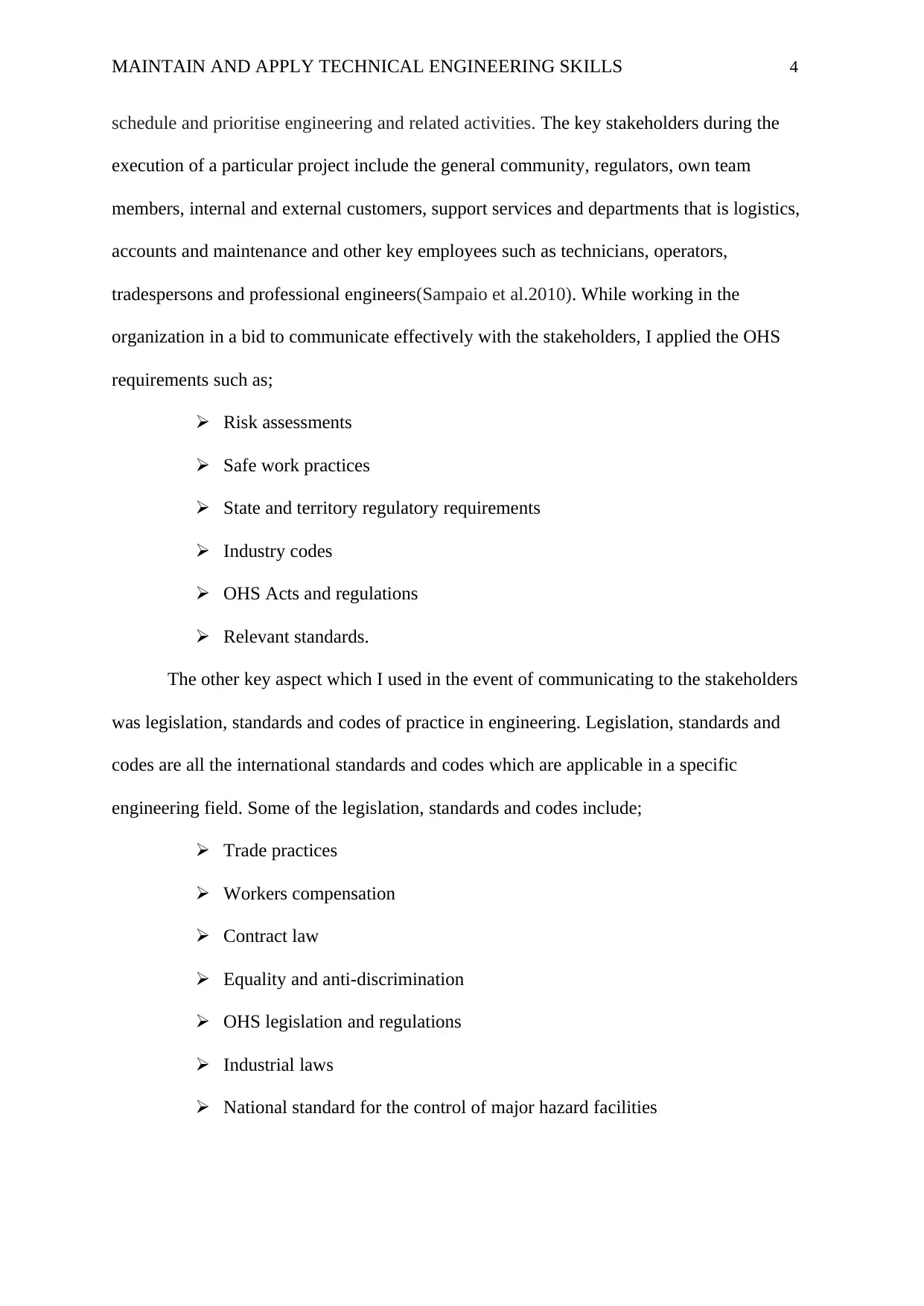
MAINTAIN AND APPLY TECHNICAL ENGINEERING SKILLS 4
schedule and prioritise engineering and related activities. The key stakeholders during the
execution of a particular project include the general community, regulators, own team
members, internal and external customers, support services and departments that is logistics,
accounts and maintenance and other key employees such as technicians, operators,
tradespersons and professional engineers(Sampaio et al.2010). While working in the
organization in a bid to communicate effectively with the stakeholders, I applied the OHS
requirements such as;
Risk assessments
Safe work practices
State and territory regulatory requirements
Industry codes
OHS Acts and regulations
Relevant standards.
The other key aspect which I used in the event of communicating to the stakeholders
was legislation, standards and codes of practice in engineering. Legislation, standards and
codes are all the international standards and codes which are applicable in a specific
engineering field. Some of the legislation, standards and codes include;
Trade practices
Workers compensation
Contract law
Equality and anti-discrimination
OHS legislation and regulations
Industrial laws
National standard for the control of major hazard facilities
schedule and prioritise engineering and related activities. The key stakeholders during the
execution of a particular project include the general community, regulators, own team
members, internal and external customers, support services and departments that is logistics,
accounts and maintenance and other key employees such as technicians, operators,
tradespersons and professional engineers(Sampaio et al.2010). While working in the
organization in a bid to communicate effectively with the stakeholders, I applied the OHS
requirements such as;
Risk assessments
Safe work practices
State and territory regulatory requirements
Industry codes
OHS Acts and regulations
Relevant standards.
The other key aspect which I used in the event of communicating to the stakeholders
was legislation, standards and codes of practice in engineering. Legislation, standards and
codes are all the international standards and codes which are applicable in a specific
engineering field. Some of the legislation, standards and codes include;
Trade practices
Workers compensation
Contract law
Equality and anti-discrimination
OHS legislation and regulations
Industrial laws
National standard for the control of major hazard facilities
Paraphrase This Document
Need a fresh take? Get an instant paraphrase of this document with our AI Paraphraser
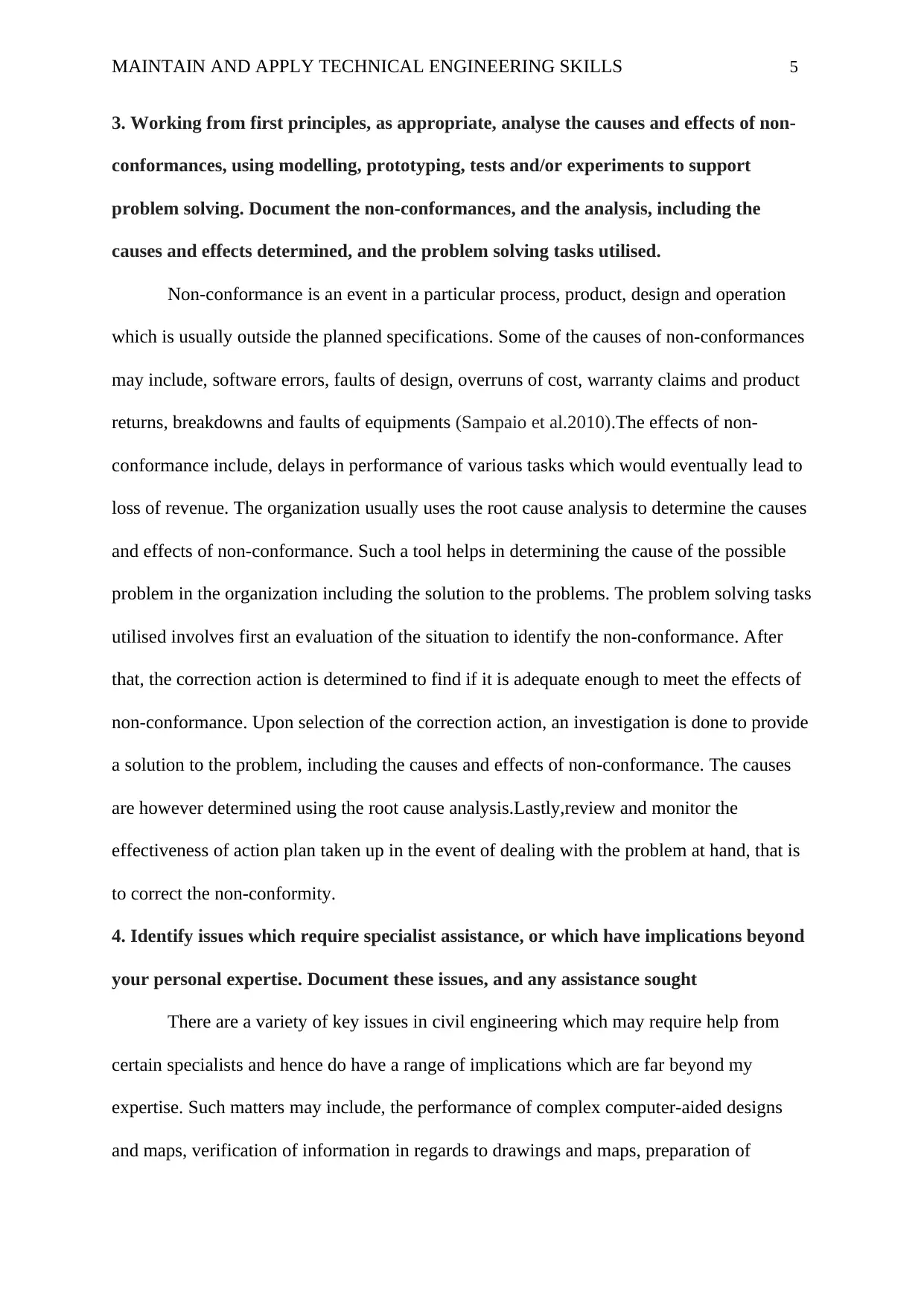
MAINTAIN AND APPLY TECHNICAL ENGINEERING SKILLS 5
3. Working from first principles, as appropriate, analyse the causes and effects of non-
conformances, using modelling, prototyping, tests and/or experiments to support
problem solving. Document the non-conformances, and the analysis, including the
causes and effects determined, and the problem solving tasks utilised.
Non-conformance is an event in a particular process, product, design and operation
which is usually outside the planned specifications. Some of the causes of non-conformances
may include, software errors, faults of design, overruns of cost, warranty claims and product
returns, breakdowns and faults of equipments (Sampaio et al.2010).The effects of non-
conformance include, delays in performance of various tasks which would eventually lead to
loss of revenue. The organization usually uses the root cause analysis to determine the causes
and effects of non-conformance. Such a tool helps in determining the cause of the possible
problem in the organization including the solution to the problems. The problem solving tasks
utilised involves first an evaluation of the situation to identify the non-conformance. After
that, the correction action is determined to find if it is adequate enough to meet the effects of
non-conformance. Upon selection of the correction action, an investigation is done to provide
a solution to the problem, including the causes and effects of non-conformance. The causes
are however determined using the root cause analysis.Lastly,review and monitor the
effectiveness of action plan taken up in the event of dealing with the problem at hand, that is
to correct the non-conformity.
4. Identify issues which require specialist assistance, or which have implications beyond
your personal expertise. Document these issues, and any assistance sought
There are a variety of key issues in civil engineering which may require help from
certain specialists and hence do have a range of implications which are far beyond my
expertise. Such matters may include, the performance of complex computer-aided designs
and maps, verification of information in regards to drawings and maps, preparation of
3. Working from first principles, as appropriate, analyse the causes and effects of non-
conformances, using modelling, prototyping, tests and/or experiments to support
problem solving. Document the non-conformances, and the analysis, including the
causes and effects determined, and the problem solving tasks utilised.
Non-conformance is an event in a particular process, product, design and operation
which is usually outside the planned specifications. Some of the causes of non-conformances
may include, software errors, faults of design, overruns of cost, warranty claims and product
returns, breakdowns and faults of equipments (Sampaio et al.2010).The effects of non-
conformance include, delays in performance of various tasks which would eventually lead to
loss of revenue. The organization usually uses the root cause analysis to determine the causes
and effects of non-conformance. Such a tool helps in determining the cause of the possible
problem in the organization including the solution to the problems. The problem solving tasks
utilised involves first an evaluation of the situation to identify the non-conformance. After
that, the correction action is determined to find if it is adequate enough to meet the effects of
non-conformance. Upon selection of the correction action, an investigation is done to provide
a solution to the problem, including the causes and effects of non-conformance. The causes
are however determined using the root cause analysis.Lastly,review and monitor the
effectiveness of action plan taken up in the event of dealing with the problem at hand, that is
to correct the non-conformity.
4. Identify issues which require specialist assistance, or which have implications beyond
your personal expertise. Document these issues, and any assistance sought
There are a variety of key issues in civil engineering which may require help from
certain specialists and hence do have a range of implications which are far beyond my
expertise. Such matters may include, the performance of complex computer-aided designs
and maps, verification of information in regards to drawings and maps, preparation of
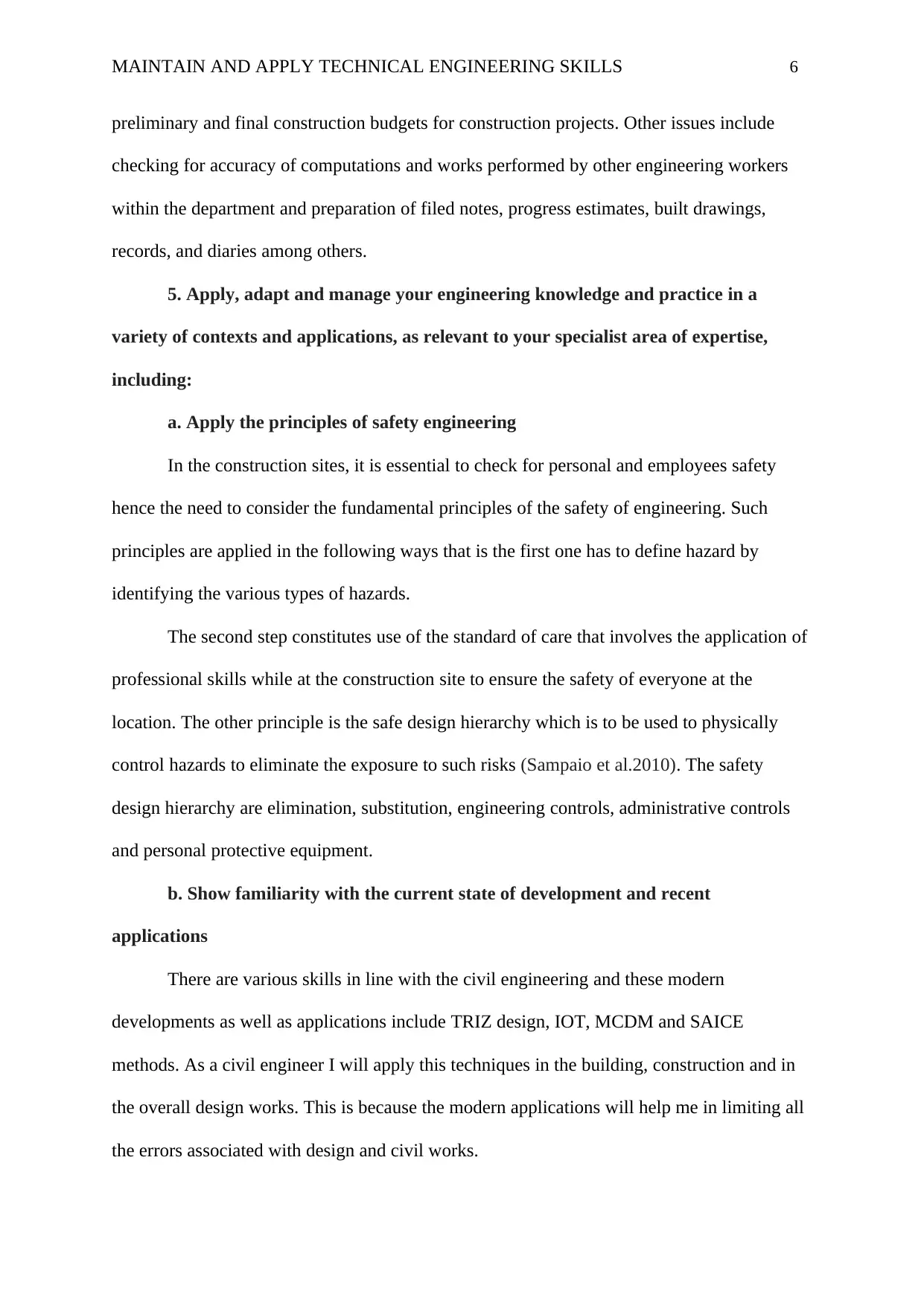
MAINTAIN AND APPLY TECHNICAL ENGINEERING SKILLS 6
preliminary and final construction budgets for construction projects. Other issues include
checking for accuracy of computations and works performed by other engineering workers
within the department and preparation of filed notes, progress estimates, built drawings,
records, and diaries among others.
5. Apply, adapt and manage your engineering knowledge and practice in a
variety of contexts and applications, as relevant to your specialist area of expertise,
including:
a. Apply the principles of safety engineering
In the construction sites, it is essential to check for personal and employees safety
hence the need to consider the fundamental principles of the safety of engineering. Such
principles are applied in the following ways that is the first one has to define hazard by
identifying the various types of hazards.
The second step constitutes use of the standard of care that involves the application of
professional skills while at the construction site to ensure the safety of everyone at the
location. The other principle is the safe design hierarchy which is to be used to physically
control hazards to eliminate the exposure to such risks (Sampaio et al.2010). The safety
design hierarchy are elimination, substitution, engineering controls, administrative controls
and personal protective equipment.
b. Show familiarity with the current state of development and recent
applications
There are various skills in line with the civil engineering and these modern
developments as well as applications include TRIZ design, IOT, MCDM and SAICE
methods. As a civil engineer I will apply this techniques in the building, construction and in
the overall design works. This is because the modern applications will help me in limiting all
the errors associated with design and civil works.
preliminary and final construction budgets for construction projects. Other issues include
checking for accuracy of computations and works performed by other engineering workers
within the department and preparation of filed notes, progress estimates, built drawings,
records, and diaries among others.
5. Apply, adapt and manage your engineering knowledge and practice in a
variety of contexts and applications, as relevant to your specialist area of expertise,
including:
a. Apply the principles of safety engineering
In the construction sites, it is essential to check for personal and employees safety
hence the need to consider the fundamental principles of the safety of engineering. Such
principles are applied in the following ways that is the first one has to define hazard by
identifying the various types of hazards.
The second step constitutes use of the standard of care that involves the application of
professional skills while at the construction site to ensure the safety of everyone at the
location. The other principle is the safe design hierarchy which is to be used to physically
control hazards to eliminate the exposure to such risks (Sampaio et al.2010). The safety
design hierarchy are elimination, substitution, engineering controls, administrative controls
and personal protective equipment.
b. Show familiarity with the current state of development and recent
applications
There are various skills in line with the civil engineering and these modern
developments as well as applications include TRIZ design, IOT, MCDM and SAICE
methods. As a civil engineer I will apply this techniques in the building, construction and in
the overall design works. This is because the modern applications will help me in limiting all
the errors associated with design and civil works.
⊘ This is a preview!⊘
Do you want full access?
Subscribe today to unlock all pages.

Trusted by 1+ million students worldwide
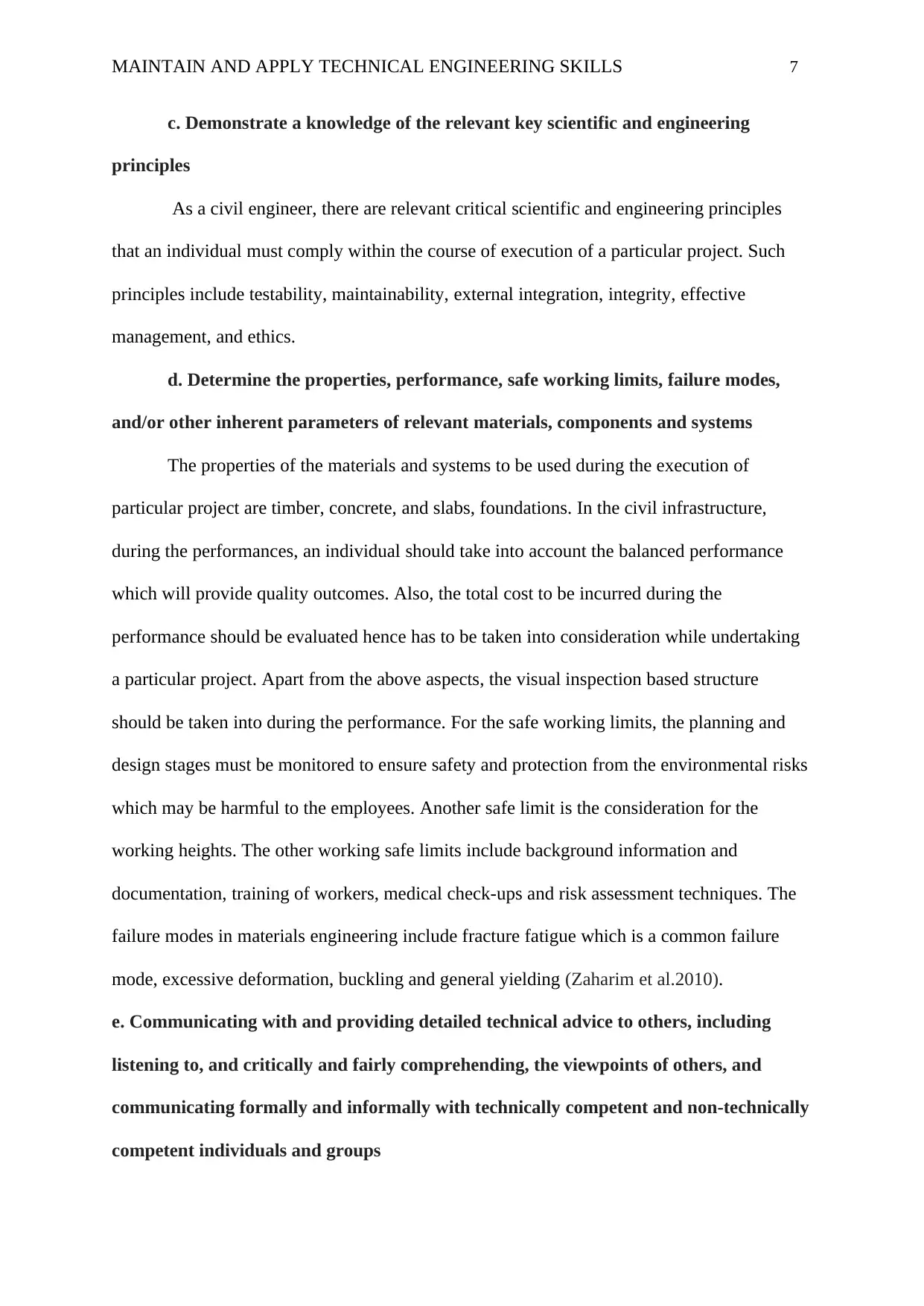
MAINTAIN AND APPLY TECHNICAL ENGINEERING SKILLS 7
c. Demonstrate a knowledge of the relevant key scientific and engineering
principles
As a civil engineer, there are relevant critical scientific and engineering principles
that an individual must comply within the course of execution of a particular project. Such
principles include testability, maintainability, external integration, integrity, effective
management, and ethics.
d. Determine the properties, performance, safe working limits, failure modes,
and/or other inherent parameters of relevant materials, components and systems
The properties of the materials and systems to be used during the execution of
particular project are timber, concrete, and slabs, foundations. In the civil infrastructure,
during the performances, an individual should take into account the balanced performance
which will provide quality outcomes. Also, the total cost to be incurred during the
performance should be evaluated hence has to be taken into consideration while undertaking
a particular project. Apart from the above aspects, the visual inspection based structure
should be taken into during the performance. For the safe working limits, the planning and
design stages must be monitored to ensure safety and protection from the environmental risks
which may be harmful to the employees. Another safe limit is the consideration for the
working heights. The other working safe limits include background information and
documentation, training of workers, medical check-ups and risk assessment techniques. The
failure modes in materials engineering include fracture fatigue which is a common failure
mode, excessive deformation, buckling and general yielding (Zaharim et al.2010).
e. Communicating with and providing detailed technical advice to others, including
listening to, and critically and fairly comprehending, the viewpoints of others, and
communicating formally and informally with technically competent and non-technically
competent individuals and groups
c. Demonstrate a knowledge of the relevant key scientific and engineering
principles
As a civil engineer, there are relevant critical scientific and engineering principles
that an individual must comply within the course of execution of a particular project. Such
principles include testability, maintainability, external integration, integrity, effective
management, and ethics.
d. Determine the properties, performance, safe working limits, failure modes,
and/or other inherent parameters of relevant materials, components and systems
The properties of the materials and systems to be used during the execution of
particular project are timber, concrete, and slabs, foundations. In the civil infrastructure,
during the performances, an individual should take into account the balanced performance
which will provide quality outcomes. Also, the total cost to be incurred during the
performance should be evaluated hence has to be taken into consideration while undertaking
a particular project. Apart from the above aspects, the visual inspection based structure
should be taken into during the performance. For the safe working limits, the planning and
design stages must be monitored to ensure safety and protection from the environmental risks
which may be harmful to the employees. Another safe limit is the consideration for the
working heights. The other working safe limits include background information and
documentation, training of workers, medical check-ups and risk assessment techniques. The
failure modes in materials engineering include fracture fatigue which is a common failure
mode, excessive deformation, buckling and general yielding (Zaharim et al.2010).
e. Communicating with and providing detailed technical advice to others, including
listening to, and critically and fairly comprehending, the viewpoints of others, and
communicating formally and informally with technically competent and non-technically
competent individuals and groups
Paraphrase This Document
Need a fresh take? Get an instant paraphrase of this document with our AI Paraphraser
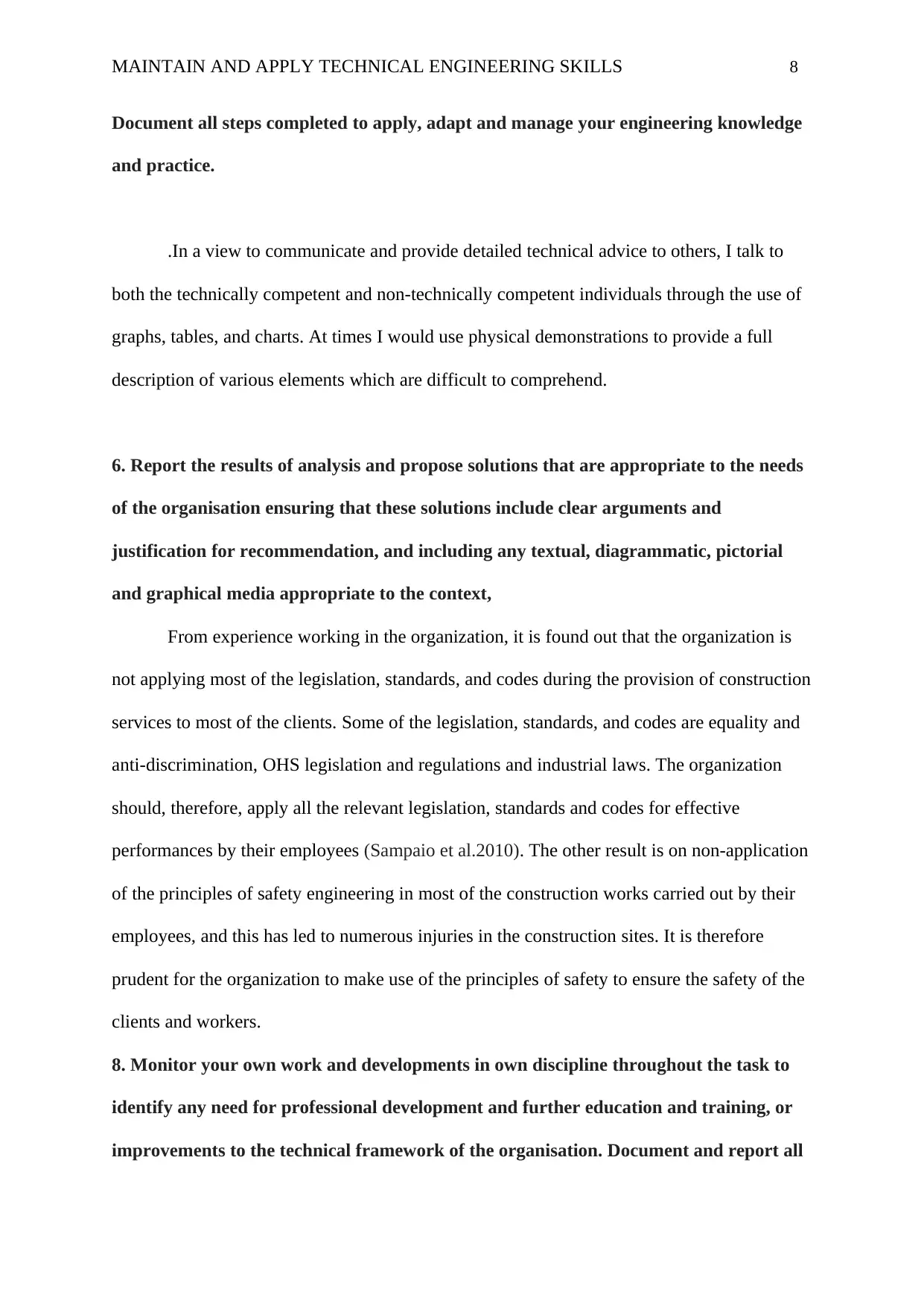
MAINTAIN AND APPLY TECHNICAL ENGINEERING SKILLS 8
Document all steps completed to apply, adapt and manage your engineering knowledge
and practice.
.In a view to communicate and provide detailed technical advice to others, I talk to
both the technically competent and non-technically competent individuals through the use of
graphs, tables, and charts. At times I would use physical demonstrations to provide a full
description of various elements which are difficult to comprehend.
6. Report the results of analysis and propose solutions that are appropriate to the needs
of the organisation ensuring that these solutions include clear arguments and
justification for recommendation, and including any textual, diagrammatic, pictorial
and graphical media appropriate to the context,
From experience working in the organization, it is found out that the organization is
not applying most of the legislation, standards, and codes during the provision of construction
services to most of the clients. Some of the legislation, standards, and codes are equality and
anti-discrimination, OHS legislation and regulations and industrial laws. The organization
should, therefore, apply all the relevant legislation, standards and codes for effective
performances by their employees (Sampaio et al.2010). The other result is on non-application
of the principles of safety engineering in most of the construction works carried out by their
employees, and this has led to numerous injuries in the construction sites. It is therefore
prudent for the organization to make use of the principles of safety to ensure the safety of the
clients and workers.
8. Monitor your own work and developments in own discipline throughout the task to
identify any need for professional development and further education and training, or
improvements to the technical framework of the organisation. Document and report all
Document all steps completed to apply, adapt and manage your engineering knowledge
and practice.
.In a view to communicate and provide detailed technical advice to others, I talk to
both the technically competent and non-technically competent individuals through the use of
graphs, tables, and charts. At times I would use physical demonstrations to provide a full
description of various elements which are difficult to comprehend.
6. Report the results of analysis and propose solutions that are appropriate to the needs
of the organisation ensuring that these solutions include clear arguments and
justification for recommendation, and including any textual, diagrammatic, pictorial
and graphical media appropriate to the context,
From experience working in the organization, it is found out that the organization is
not applying most of the legislation, standards, and codes during the provision of construction
services to most of the clients. Some of the legislation, standards, and codes are equality and
anti-discrimination, OHS legislation and regulations and industrial laws. The organization
should, therefore, apply all the relevant legislation, standards and codes for effective
performances by their employees (Sampaio et al.2010). The other result is on non-application
of the principles of safety engineering in most of the construction works carried out by their
employees, and this has led to numerous injuries in the construction sites. It is therefore
prudent for the organization to make use of the principles of safety to ensure the safety of the
clients and workers.
8. Monitor your own work and developments in own discipline throughout the task to
identify any need for professional development and further education and training, or
improvements to the technical framework of the organisation. Document and report all
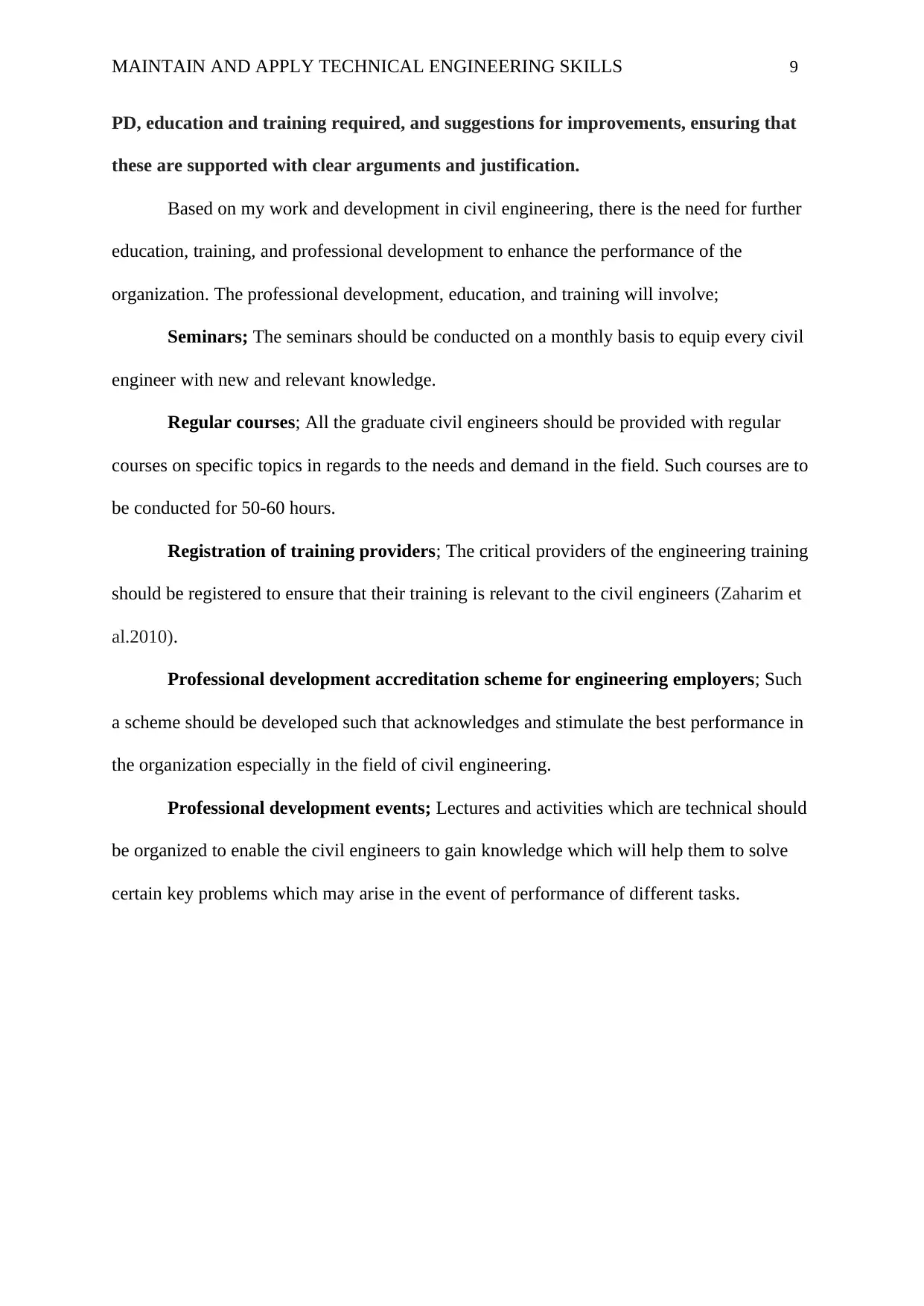
MAINTAIN AND APPLY TECHNICAL ENGINEERING SKILLS 9
PD, education and training required, and suggestions for improvements, ensuring that
these are supported with clear arguments and justification.
Based on my work and development in civil engineering, there is the need for further
education, training, and professional development to enhance the performance of the
organization. The professional development, education, and training will involve;
Seminars; The seminars should be conducted on a monthly basis to equip every civil
engineer with new and relevant knowledge.
Regular courses; All the graduate civil engineers should be provided with regular
courses on specific topics in regards to the needs and demand in the field. Such courses are to
be conducted for 50-60 hours.
Registration of training providers; The critical providers of the engineering training
should be registered to ensure that their training is relevant to the civil engineers (Zaharim et
al.2010).
Professional development accreditation scheme for engineering employers; Such
a scheme should be developed such that acknowledges and stimulate the best performance in
the organization especially in the field of civil engineering.
Professional development events; Lectures and activities which are technical should
be organized to enable the civil engineers to gain knowledge which will help them to solve
certain key problems which may arise in the event of performance of different tasks.
PD, education and training required, and suggestions for improvements, ensuring that
these are supported with clear arguments and justification.
Based on my work and development in civil engineering, there is the need for further
education, training, and professional development to enhance the performance of the
organization. The professional development, education, and training will involve;
Seminars; The seminars should be conducted on a monthly basis to equip every civil
engineer with new and relevant knowledge.
Regular courses; All the graduate civil engineers should be provided with regular
courses on specific topics in regards to the needs and demand in the field. Such courses are to
be conducted for 50-60 hours.
Registration of training providers; The critical providers of the engineering training
should be registered to ensure that their training is relevant to the civil engineers (Zaharim et
al.2010).
Professional development accreditation scheme for engineering employers; Such
a scheme should be developed such that acknowledges and stimulate the best performance in
the organization especially in the field of civil engineering.
Professional development events; Lectures and activities which are technical should
be organized to enable the civil engineers to gain knowledge which will help them to solve
certain key problems which may arise in the event of performance of different tasks.
⊘ This is a preview!⊘
Do you want full access?
Subscribe today to unlock all pages.

Trusted by 1+ million students worldwide
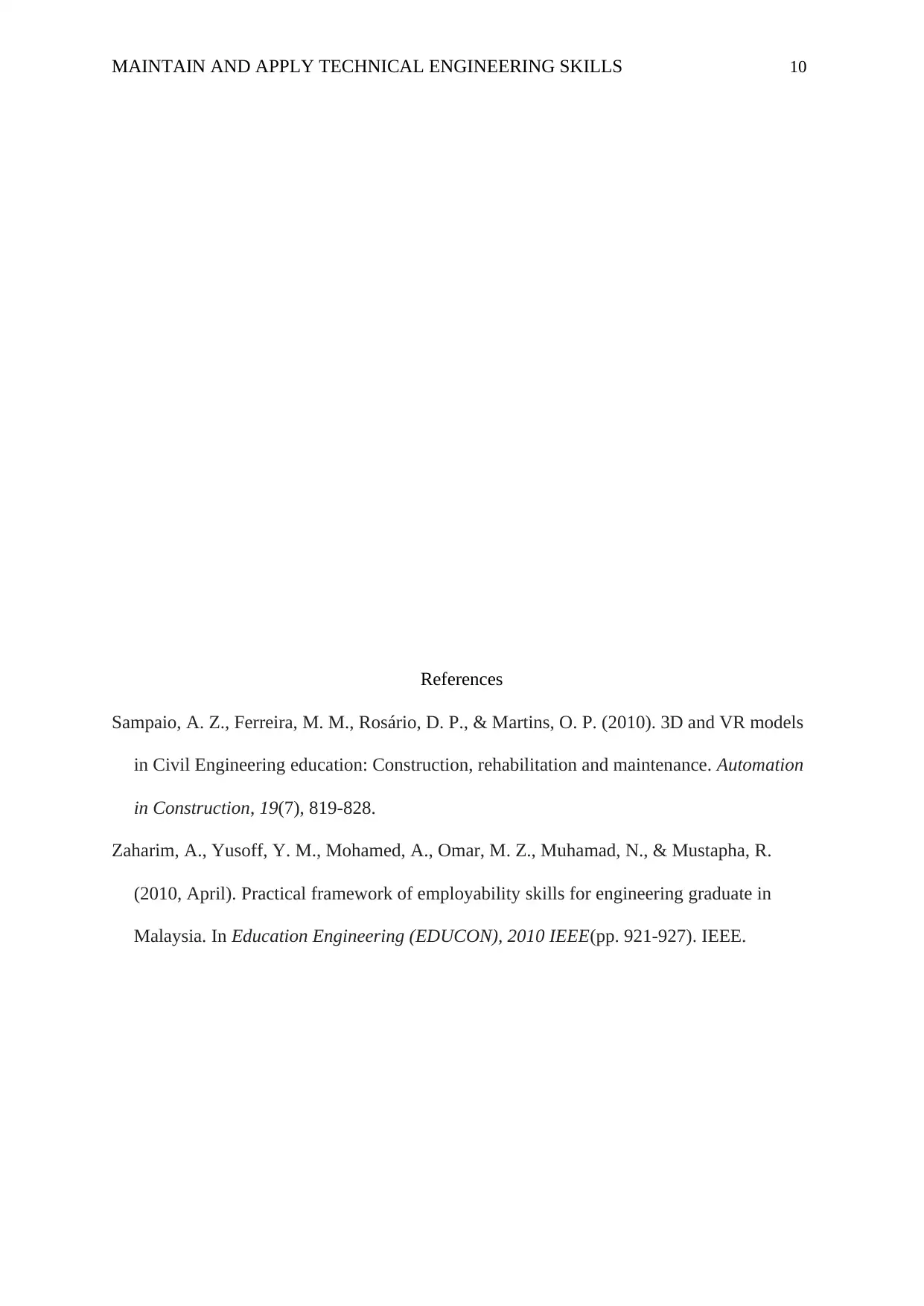
MAINTAIN AND APPLY TECHNICAL ENGINEERING SKILLS 10
References
Sampaio, A. Z., Ferreira, M. M., Rosário, D. P., & Martins, O. P. (2010). 3D and VR models
in Civil Engineering education: Construction, rehabilitation and maintenance. Automation
in Construction, 19(7), 819-828.
Zaharim, A., Yusoff, Y. M., Mohamed, A., Omar, M. Z., Muhamad, N., & Mustapha, R.
(2010, April). Practical framework of employability skills for engineering graduate in
Malaysia. In Education Engineering (EDUCON), 2010 IEEE(pp. 921-927). IEEE.
References
Sampaio, A. Z., Ferreira, M. M., Rosário, D. P., & Martins, O. P. (2010). 3D and VR models
in Civil Engineering education: Construction, rehabilitation and maintenance. Automation
in Construction, 19(7), 819-828.
Zaharim, A., Yusoff, Y. M., Mohamed, A., Omar, M. Z., Muhamad, N., & Mustapha, R.
(2010, April). Practical framework of employability skills for engineering graduate in
Malaysia. In Education Engineering (EDUCON), 2010 IEEE(pp. 921-927). IEEE.
1 out of 10
Related Documents
Your All-in-One AI-Powered Toolkit for Academic Success.
+13062052269
info@desklib.com
Available 24*7 on WhatsApp / Email
![[object Object]](/_next/static/media/star-bottom.7253800d.svg)
Unlock your academic potential
Copyright © 2020–2025 A2Z Services. All Rights Reserved. Developed and managed by ZUCOL.





